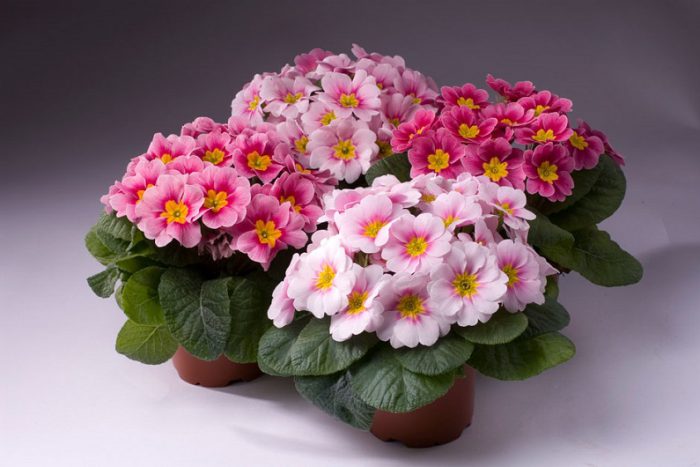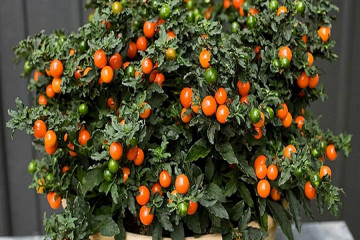Reproduction of primrose: basic methods and examples at home
Content:
Primroses are flowers that most gardeners like. There are about half a thousand varieties of these plants. Each of them has individual characteristics of care and reproduction. Propagation of primrose is possible in several ways. The article describes how to grow primrose in different ways.
What does it look like and what family it belongs to
Primula has a different name - primrose. It is a perennial plant and belongs to the primrose genus. Naturally grows in northern Africa, Central Asia, Europe and the Middle East.
The flower in question includes about 500 species. However, in the natural environment, you can find those species that have not yet been described.
The root rosette of the plant includes leaves that can be dissected or simple. Their shape is oblong-oval lanceolate. Leaves can be either sessile or petiolate. There are also wrinkled and leathery leaves. The latter are very dense. They are green in color with a gray tint.
Peduncles are long. There are no leaves on them. There are species with both single flowers and whole inflorescences. The shape of the flowers is very diverse: in the form of a ball, an umbrella, a pyramid, a bell. There are also tiered and cushion-shaped. The flowers are tubular with a flat or funnel-shaped limb. There are both annual and perennial species.
Common varieties
All primrose varieties are divided into 30 sections. The following are the most popular types and varieties:
Ordinary
Grows in central and southern Europe. Places of distribution: forest edges, alpine meadows. The rhizome is short with thick roots, like laces. Lanceolate leaves are 25 cm, width - 6 cm. Peduncles can be from 6 to 20 cm. Flowers are solitary, pale yellow or white. The petals are wide, divided into two lobes. Flowering begins in March. Sometimes you bloom again in September.
Common varieties:
- Virginia: white flowers with a pale yellow throat;
- Giga White: snow-white flowers;
- Cerulea: The flowers are blue with a yellow fauces.
High
Origin from the Carpathians and the southern and northern parts of Western Europe. Leaves are oval in shape with a finely toothed edge. The length of the leaf blades is 5-20 cm, the width is 2-7 cm. The leaves are strongly tapering towards the petiole. On the front side, the veins on the leaves are depressed, and on the seamy side they are convex. The inflorescences are in the shape of an umbrella. They consist of 5-15 flowers. The diameter of the flowers is 2 cm. Their color is pale yellow. Peduncle height 10-35 cm. Bloom in April for 60 days.
Varieties of this type:
- Duplex: cherry blossoms, diameter 25 cm;
- Rosea: flowers are dark pink;
- Gele Farben: lavender inflorescences, diameter 95 mm;
- Gold Grand: brown buds, diameter 25 mm.
Siebold
Blooms in June. Flowers can be pink or lilac. The inflorescences look like an umbrella.
Spring
Also called Medicinal. Origin: Europe. Leaves are ovoid and wrinkled. Their length is 20 cm, and their width is 6 cm. From the front, the veins are depressed, and from the wrong side, they are convex. Flowers are yellow in color with an orange spot at the base.They can be terry or smooth. Blooms from April to June.
History of appearance
The primrose has been known for many hundreds of years. In ancient Greece, it was called the medicinal flower of Olympus. Also, the people called it "keys" or "rams". According to the myths of ancient Scandinavia, the flowers of this plant are the keys of the fertility goddess Freya. Thanks to them, she lets spring in. In Germany, these flowers are believed to be the keys to getting married. Among the Celts and Gauls, primrose was present in love potions.
According to the stories of Denmark, an elf princess turned into this flower because she fell in love with an ordinary person.
Ancient Greek myths tell that a young man named Paralysos died of love. He was turned into primroses by the gods. The gods were very sorry for his death.
In European countries, this flower has been cultivated since the 16th century. The British have a special affection for him, who even created a club for primrose lovers. Every year there are exhibitions of primroses.
Home care
It is quite simple to care for a primrose at home. It is better to keep it where there is good lighting. It is also important not to overflow the plant. Otherwise, it can get sick with rot.
Humidity
There are no specific requirements for air humidity. However, if the humidity is too low, the edges of the leaves begin to dry. In this case, it is required to spray the leaves with soft water.
Temperature
The room where the plant lives should be cool. When blooming, the recommended temperature is 12-15 degrees.
Watering
When flowering, watering is necessary often, as it is required that the soil is constantly moistened. However, it is worth remembering that it is impossible to fill the flower, as this will provoke the development of rot on the roots. After flowering, water should be moderate.
Top dressing
Top dressing is carried out after the buds have formed. Complex formulations with microelements are used as fertilizers. Top dressing is carried out twice a month, before flowering ends. If you fertilize the flower before the buds appear, then all the power will go into the foliage. After the flowers fall off, the plant is transplanted into open ground or into another pot.
The soil
To plant a plant, an earth mixture is used. A good mixture should consist of leafy soil, peat soil, sand. Everything is taken in the same proportions. A drainage layer is also required.
Landing rules
For landing, the following rules must be observed:
- there should not be a large amount of mineral salts in the ground;
- flowers should be well lit;
- the temperature where the flowers are located should be low;
- dried leaves must be removed immediately so that the flower blooms well;
- the transplant is carried out only after flowering;
- drainage is required at the bottom of the pot.
Seeds are planted from November to December. Primrose seeds will give good germination if, before planting them, keep them in high humidity at a temperature of 20 degrees. Further, the temperature and humidity gradually decrease. The dive is carried out twice: in March and April.
Reproduction methods
There are several options for how primrose propagates: by seeds, dividing the bush and cuttings.
Small-toothed primrose: growing from seeds
Growing primrose from seeds is the most affordable, but not an easy way. But having studied how to grow primrose from seeds at home for seedlings, you can get a beautiful healthy plant. The seeds are taught by artificial pollination.For germination, a stratification procedure is carried out. To do this, they are placed on a damp cloth and placed in the refrigerator.
Sowing is done in June or July. The capacity should be wide and low. From above, the seeds are sprinkled with a thin layer of earth. Then the container is covered with glass or foil. Planting should be in a shaded area. Temperature range 15-18 degrees. The first shoots appear in two weeks.
For primrose seedlings, light and loose peat-based soil is used. Seeds are planted Some suggest using snow instead of watering. Seed ridicule happens right in the snow. Melting snow will pull them into the ground. Cover the container with foil and put it in the refrigerator for a month. The temperature should be at least 10 degrees.
After the stratification process, the seeds are transferred to the room. Many primroses germinate in the light at a temperature of +15 - +18 degrees. Seedlings should get accustomed to the air gradually. It is possible to completely remove the film only after a week and a half. Primrose seedlings from seeds must be protected from direct exposure to the sun. It is also required to maintain soil moisture. It is necessary to dive the plant after 1-2 leaves appear.
Growing primrose from seeds is a long process. It is recommended to grow them in a pot until next spring. The plant begins to bloom only in the third or fourth year.
How can you propagate a primrose by dividing a bush
Primrose can be propagated by dividing the bush. This method can be used not only for reproduction, but also for plant rejuvenation. You should not keep the flower in one place for more than five years. If it is not divided, then the leaves and flowers become small.
The plant to be divided is watered abundantly. Then, two hours later, it is dug up. Next, they are disassembled into sockets. In young species, the separation is easier. Old plants have to use a knife. A piece of rhizome is left at each part.
The shoots are planted in holes at a distance of 15-20 cm. The holes should be filled with humus and spilled. Then, daily watering is carried out for 7-10 days. It is impossible to fill in so as not to rot the rhizome.
Leafy cuttings
The method of propagation of primrose by leaf cuttings is used when it is too early to propagate the bush. Several outlets must be carefully plucked from the plant. They then take root in a cool and shaded place.
For rooting, the rosettes must be placed in the grooves. Cut sphagnum moss is required to be laid on their bottom. The roots will appear very quickly - in half a month. Then the cutting is planted in a pot. Its diameter should not be large. The pot is placed in a cold greenhouse during the spring. Next, a transfer to a permanent place is carried out. Planted rosettes in the ground for the winter period are covered with leaves.
In a situation where, when dividing the bush, pieces of rhizome remain, it is possible to try the method of propagation by root cuttings. To do this, they are planted in a light nutritious soil. The planting depth is 2.5-3 cm. If you observe normal air humidity and warmth, then new sockets will come out of the buds.
Primrose is a flower that can grow both indoors and outdoors. There are numerous varieties of this plant. To propagate it, three methods are used: seed, cuttings or dividing the bush. The first one is the most preferred. Primrose is easy to take care of.
























